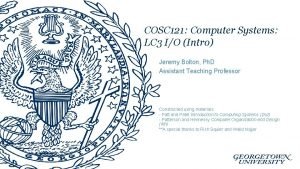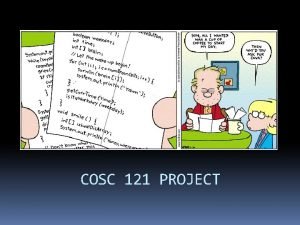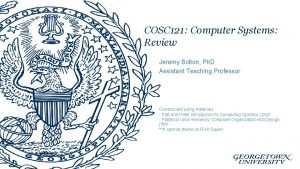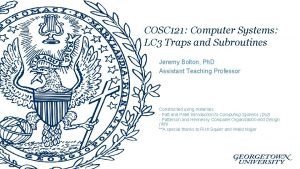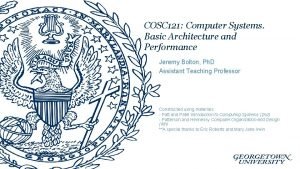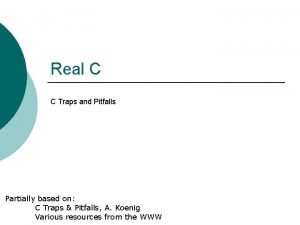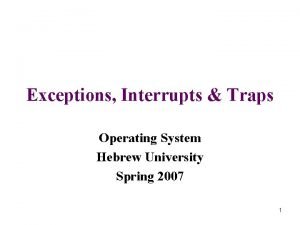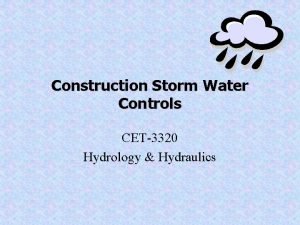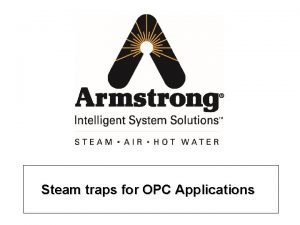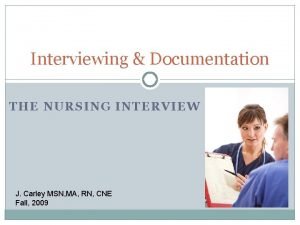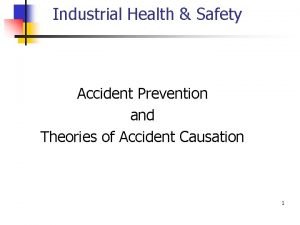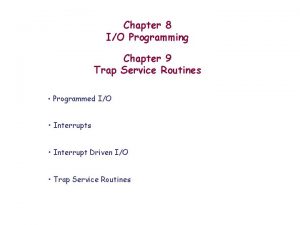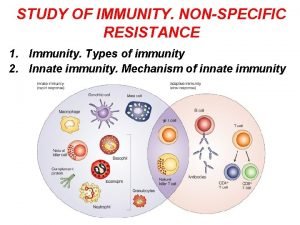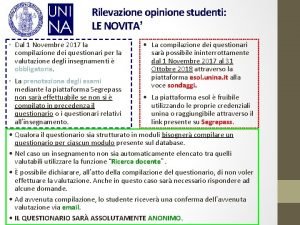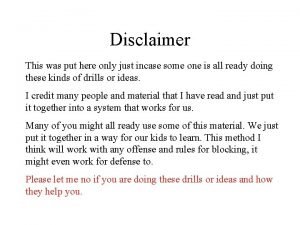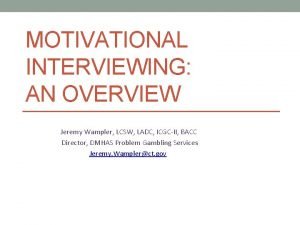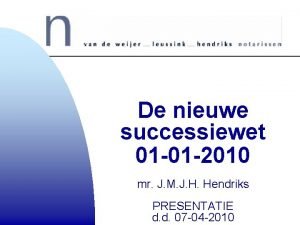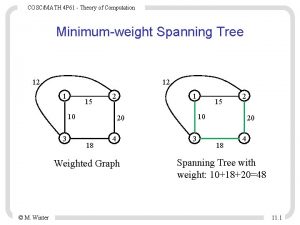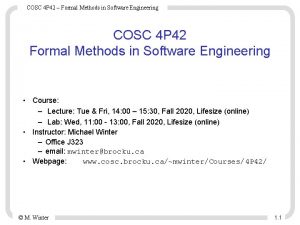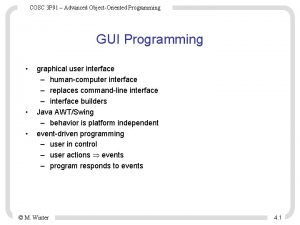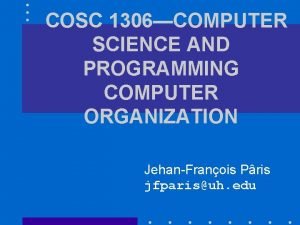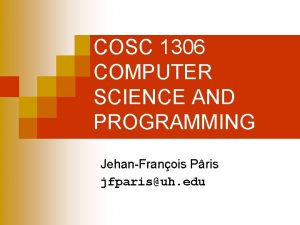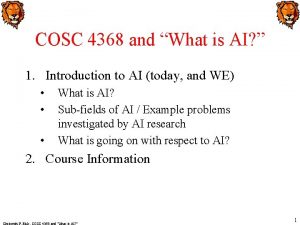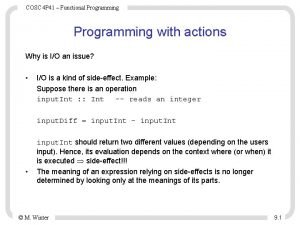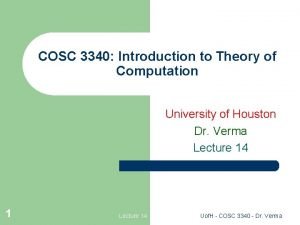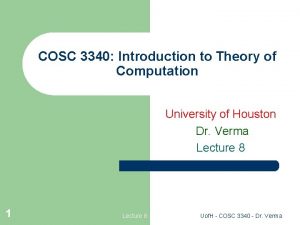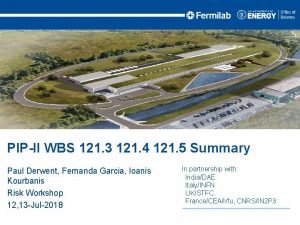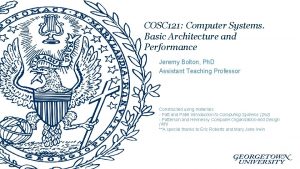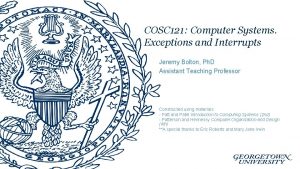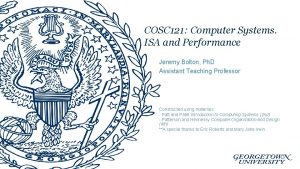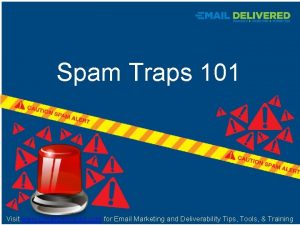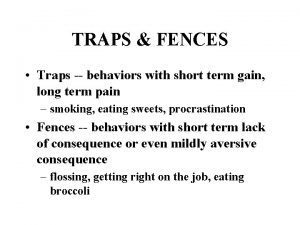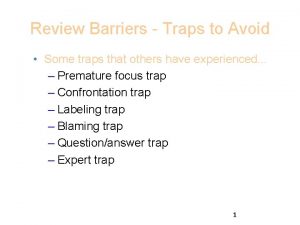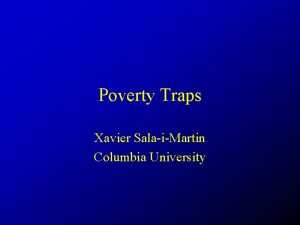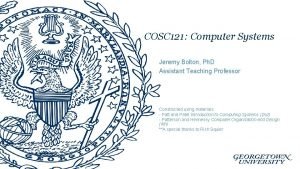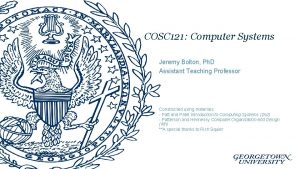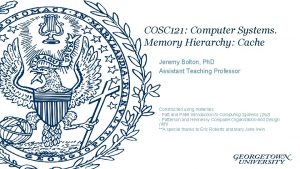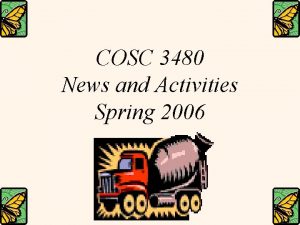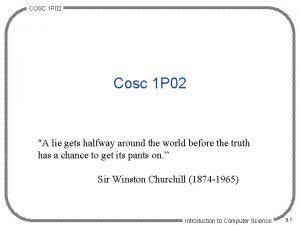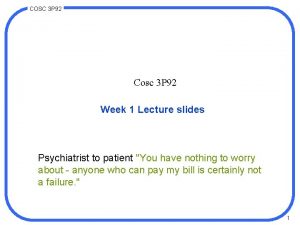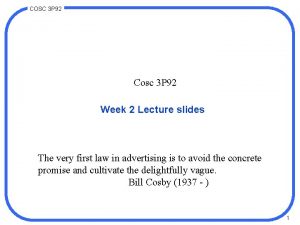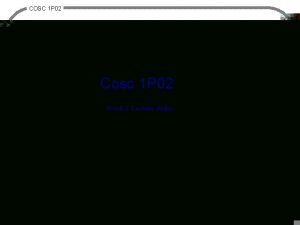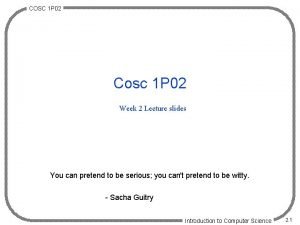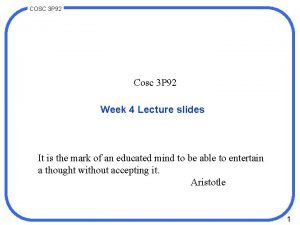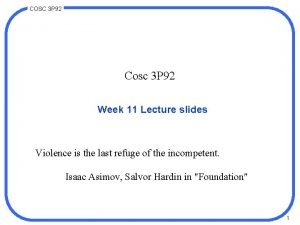COSC 121 Computer Systems LC 3 Traps and










































- Slides: 42

COSC 121: Computer Systems: LC 3 Traps and Subroutines Jeremy Bolton, Ph. D Assistant Teaching Professor Constructed using materials: - Patt and Patel Introduction to Computing Systems (2 nd) - Patterson and Hennessy Computer Organization and Design (4 th) **A special thanks to Rich Squier and Walid Najjar

Notes • Read PP. 9 • HW #4 (upcoming) • Project #1 Posted (in parts) Due Soon! – Supplemental files

Outline • Overview of – Operating System Intro – Trap routines – User Subroutines • Passing and saving data • Standards and protocols – Subroutines calling subroutines … what could go wrong?

This week … our journey takes us … COSC 121: Computer Systems Application (Browser) Operating System (Win, Linux) Compiler Software Hardware Assembler Drivers Processor Memory I/O system COSC 255: Operating Systems Instruction Set Architecture Datapath & Control Digital Design Circuit Design transistors COSC 120: Computer Hardware

PP. 9 TRAP Routines and Subroutines

System Calls • Certain operations require specialized knowledge and protection: – specific knowledge of I/O device registers and the sequence of operations needed to use them – I/O resources shared among multiple users/programs; a mistake could affect lots of other users! • Not every programmer knows (or wants to know) this level of detail • Provide service routines or system calls (part of operating system) to safely and conveniently perform low-level, privileged operations 9 -6

System Call • 1. User program invokes system call. • 2. Operating system code performs operation. • 3. Returns control to user program. In LC-3, this is done through the TRAP mechanism. 9 -7

LC-3 TRAP Mechanism • 1. A set of service routines. – part of operating system -- routines start at arbitrary addresses up to 256 routines • 2. Table of starting addresses. – stored at x 0000 through x 00 FF in memory – called System Control Block in some architectures • 3. TRAP instruction. – used by program to transfer control to operating system – 8 -bit trap vector names one of the 256 service routines • 4. A linkage back to the user program. – want execution to resume immediately after the TRAP instruction. Must save the “way back” 9 -8

LC-3 TRAP Routines – GETC (TRAP x 20) • Read a single character from KBD. • Write ASCII code to R 0[7: 0], clear R 0[15: 8]. – OUT (TRAP x 21) • Write R 0[7: 0] to the monitor. – PUTS (TRAP x 22) • Write a string to monitor (address of first character of string is in R 0). – IN (TRAP x 23) • Print a prompt to the monitor and read a single character from KBD. • Write ASCII code to R 0[7: 0], clear R 0[15: 8], echo character to the monitor. – HALT (TRAP x 25) • Print message to monitor & halt execution. 9 -9 Trap vector table

TRAP Instruction • Trap vector – identifies which system call to invoke – 8 -bit index into table of service routine addresses • in LC-3, this table is stored in memory at 0 x 0000 – 0 x 00 FF • 8 -bit trap vector is zero-extended into 16 -bit memory address • Where to go – lookup starting address from table; place in PC • How to get back – save address of next instruction (current PC) in R 7 9 -10

TRAP 9 -11 NOTE: PC has already been incremented during instruction fetch stage.

TRAP Mechanism Operation 1. Lookup starting address. 2. Transfer to service routine. 3. Return (JMP R 7). 9 -12

Potential Issues • Control: – How do we return to the correct PC address following the execution of a subroutine? – Must save a way back. Use R 7 in LC-3. • Data: – How are input arguments passed to subroutines? – How are return values returned from subroutines? • Use registers or pre-determined memory location. Protocol: preconditions and post conditions of subroutines should be specified. – How can we assure that the subroutine did not “corrupt” the register values? • E. G. Procedure A in the calling scope may have been in the middle of a calculation (using various registers) before calling Subroutine B. When returning from subroutine B; Procedure A continues with its calculations. Can we be sure Subroutine B did not unexpectedly alter register values being used by Procedure A?

RET (JMP R 7) • How do we transfer control back to instruction following the TRAP? • We saved old PC in R 7. – JMP R 7 gets us back to the user program at the right spot. – LC-3 assembly language lets us use RET (return) in place of “JMP R 7”. • Must make sure that service routine does not change R 7, or we won’t know where to return. 9 -14

Saving and Restoring Registers • Issue: How can we assure that the subroutine did not “corrupt” the register values? – Must save the value of a register if: • Its value will be destroyed by service routine, and • We will need to use the value after that action. • Who saves? – caller of service routine? • knows what it needs later, but may not know what gets altered by called routine – called service routine? • knows what it alters, but does not know what will be needed later by calling routine 9 -15

Example: subroutine. A subr. A LEA R 3, Binary LD R 6, ASCII ; char->digit template LD R 7, COUNT ; initialize to 10 AGAIN TRAP x 23 ; Get char ADD R 0, R 6 ; convert to number STR R 0, R 3, #0 ; store number ADD R 3, #1 ; incr pointer ADD R 7, -1 ; decr counter BRp AGAIN ; more? BRnzp NEXT What’s wrong with this routine? ASCII. FILL x. FFD 0 What happens to R 7? COUNT. FILL #10 Binary. BLKW #10 9 -16

Saving and Restoring Registers • Called routine -- “callee-save” – Before start, save any registers that will be altered (unless altered value is desired by calling program!) – When returned, restore those same registers • Calling routine -- “caller-save” – Save registers destroyed by own instructions or by called routines (if known), if values needed later • save R 7 before TRAP • save R 0 before TRAP x 23 (input character) – Or avoid using those registers altogether • Values are saved by storing them in memory. 9 -17

Caller Save • Calling routine -- “callersave” – Save registers destroyed by own instructions or by called routines (if known), if values needed later • save R 7 before TRAP • save R 0 before TRAP x 23 (input character) – Or avoid using those registers altogether •

Callee Save • Called routine -- “calleesave” – Before start of subroutine, save any registers that will be altered (unless altered value is desired by calling program!) – When returned, restore those same registers

Example: Using the TRAP Instruction. ORIG x 3000 ; Reads input and sends lowercase to monitor LD R 2, TERM ; Load negative ASCII ‘ 7’ LD R 3, ASCII ; Load ASCII difference AGAIN TRAP x 23 ; R 0 input character ADD R 1, R 2, R 0 ; Test for terminate BRz EXIT ; Exit if done ADD R 0, R 3 ; Change to lowercase TRAP x 21 ; Output to monitor. . . NEXT SLIDE BRnzp AGAIN ; . . . again and again. . . TERM. FILL x. FFC 9 ; -‘ 7’ ASCII. FILL x 0020 ; lowercase bit EXIT TRAP x 25 ; halt. END 9 -20

Example: Output Service Routine (callee) • stored in table, . ORIG x 0430 ; syscall address. R 0 input char location x 21 ST R 7, Save. R 7 ; save R 7 & R 1 ST R 1, Save. R 1 ; ----- Write character Callee save Example Try. Write LDI R 1, DSR ; get status BRzp Try. Write ; look for bit 15 on Instructions to save registers Write. It STI R 0, DDR ; write char Instructions to restore registers, ; ----- Return from TRAP before return Return LD R 1, Save. R 1 ; restore R 1 & R 7 LD R 7, Save. R 7 RET DSR. FILL DDR. FILL Save. R 1. FILL Save. R 7. FILL. END 9 -21 ; back to user x. FE 04 x. FE 06 0 0 Temp storage for registers

Concerns …. • Can a service routine call another service routine? – Sure, why not!? • If so, is there anything special the calling service routine must do? – Yes – must save data (either callee or caller save protocol) – Must save the “way” back! Must save and restore R 7 at each subroutine call. 9 -22

Can a service routine call another service routine? • The way back is “over-written” with more than one subroutine call. • All but the last “way” back is clobbered! • Can we fix this?

Can a service routine call another service routine? • Solution: Save R 7 before jump and restore just after return

What about User Code? • • Service routines provide three main functions: 1. Shield programmers from system-specific details. 2. Write frequently-used code just once. 3. Protect system resources from malicious/clumsy programmers. • Subroutines for users to … great idea! 9 -25

Subroutines • A subroutine is a program fragment that: – – lives in user space (as opposed to service routine) performs a well-defined task is invoked (called) by another user program returns control to the calling program when finished • Like a service routine, but not part of the OS – not concerned with protecting hardware resources – no special privilege required • Reasons for subroutines: – reuse useful (and debugged!) code without having to keep typing it in – divide task among multiple programmers – use vendor-supplied library of useful routines 9 -26

The Call / Return mechanism – The figure illustrates the execution of a program comprising code fragments A, W, X, Y and Z. • Note that fragment A is repeated several times, and so is well suited for packaging as a subroutine: 9 - 27

JSR Instruction • Jumps to a location (like a branch but unconditional), and saves current PC (addr of next instruction) in R 7. – saving the return address is called “linking” • “the way back” – target address is PC-relative (PC + Sext(IR[10: 0])) – bit 11 specifies addressing mode • if =1, PC-relative: target address = PC + Sext(IR[10: 0]) • if =0, register: target address = contents of register IR[8: 6] 9 -28

JSR 9 -29 NOTE: PC has already been incremented during instruction fetch stage.

JSRR Instruction • Just like JSR, except Register addressing mode. – target address is Base Register – bit 11 specifies addressing mode • What important feature does JSRR provide that JSR does not? 9 -30

JSRR 9 -31 NOTE: PC has already been incremented during instruction fetch stage.

Returning from a Subroutine • RET (JMP R 7) gets us back to the calling routine. – Assumes way back is stored in R 7 9 -32

Example: Negate the value in R 0 • 2 s. Comp NOT R 0, R 0 ; flip bits ADD R 0, #1 ; add one RET ; return to caller • To call from a program (within 1024 instructions): • ; need to compute R 4 = R 1 - R 3 ADD R 0, R 3, #0 ; copy R 3 to R 0 JSR 2 s. Comp ; negate ADD R 4, R 1, R 0 ; add to R 1. . . • Note: Neither Caller nor Callee save protocol is used here. R 0 is assumed arg in and arg out. • Way back is saved in R 7 by JSR 9 -33

Passing Information to/from Subroutines • Arguments – A value passed in to a subroutine is called an argument. – This is a value needed by the subroutine to do its job. – Examples: • In 2 s. Comp routine, R 0 is the number to be negated • In OUT service routine, R 0 is the character to be printed. • In PUTS routine, R 0 is address of string to be printed. • Return Values – A value passed out of a subroutine is called a return value. – This is the value that you called the subroutine to compute. – Examples: • In 2 s. Comp routine, negated value is returned in R 0. • In GETC service routine, character read from the keyboard is returned in R 0. 9 -34

Using Subroutines • In order to use a subroutine, a programmer must know: – its address (or at least a label that will be bound to its address) – its function (what does it do? ) • NOTE: The programmer does not need to know how the subroutine works, but what changes are visible in the machine’s state after the routine has run. – its arguments (where to pass data in, if any) – its return values (where to get computed data, if any) 9 -35

Saving and Restore Registers • Since subroutines are just like service routines, we also need to save and restore registers, if needed. • Generally use “callee-save” strategy, except for return values. – returns caller to “state” prior to call (except return values, etc) – Save anything that the subroutine will alter internally that shouldn’t be visible when the subroutine returns. – It’s good practice to restore incoming arguments to their original values (unless overwritten by return value). • Remember: You MUST save R 7 if you call any other subroutine or service routine (TRAP). – Otherwise, you won’t be able to return to caller. 9 -36

Example (1) Write a subroutine First. Char to: find the first occurrence of a particular character (in R 0) in a string (pointed to by R 1); return pointer to character or to end of string (NULL) in R 2. • (2) Use First. Char to write Count. Char, which: counts the number of occurrences of a particular character (in R 0) in a string (pointed to by R 1); return count in R 2. • Can write the second subroutine first, without knowing the implementation of First. Char! 9 -37

Count. Char Algorithm (using First. Char) save regs R 1 <- R 2 + 1 call First. Char save R 7, since we’re using JSR R 3 <- M(R 2) restore regs no R 3=0 return yes 9 -38

Count. Char Implementation 9 -39 • ; Count. Char: subroutine to count occurrences of a char Count. Char ST R 3, CCR 3 ; save registers ST R 4, CCR 4 ST R 7, CCR 7 ; JSR alters R 7 ST R 1, CCR 1 ; save original string ptr AND R 4, #0 ; initialize count to zero CC 1 JSR First. Char ; find next occurrence (ptr in R 2) LDR R 3, R 2, #0 ; see if char or null BRz CC 2 ; if null, no more chars ADD R 4, #1 ; increment count ADD R 1, R 2, #1 ; point to next char in string BRnzp CC 1 CC 2 ADD R 2, R 4, #0 ; move return val (count) to R 2 LD R 3, CCR 3 ; restore regs LD R 4, CCR 4 LD R 1, CCR 1 LD R 7, CCR 7 RET ; and return

First. Char Algorithm save regs R 3=R 0 no R 2 <- R 1 R 2 <- R 2 + 1 R 3 <- M(R 2) restore regs no R 3=0 return 9 -40 yes

First. Char Implementation • ; First. Char: subroutine to find first occurrence of a char First. Char ST R 3, FCR 3 ; save registers ST R 4, FCR 4 ; save original char NOT R 4, R 0 ; negate R 0 for comparisons ADD R 4, #1 ADD R 2, R 1, #0 ; initialize ptr to beginning of string FC 1 LDR R 3, R 2, #0 ; read character BRz FC 2 ; if null, we’re done ADD R 3, R 4 ; see if matches input char BRz FC 2 ; if yes, we’re done ADD R 2, #1 ; increment pointer BRnzp FC 1 FC 2 LD R 3, FCR 3 ; restore registers LD R 4, FCR 4 ; RET ; and return 9 -41

Library Routines • Vendor may provide object files containing useful subroutines • – don’t want to provide source code -- intellectual property – assembler/linker must support EXTERNAL symbols (or starting address of routine must be supplied to user) . . EXTERNAL SQRT • . . . LD R 2, SQAddr ; JSRR R 2. . . SQAddr. FILL SQRT load SQRT addr • Using JSRR, because we don’t know whether SQRT is within 1024 instructions. 9 -42
 Cosc 121
Cosc 121 Cosc 121
Cosc 121 Cosc 121
Cosc 121 Trap vector table lc3
Trap vector table lc3 Cosc 121
Cosc 121 C traps and pitfalls
C traps and pitfalls How to filter crawler traps
How to filter crawler traps Two factor theory psychology
Two factor theory psychology Brand identity traps
Brand identity traps Traps in operating system
Traps in operating system Sediment traps construction
Sediment traps construction Pictionary style entrepreneurship
Pictionary style entrepreneurship Sediment traps construction
Sediment traps construction Steam traps 101
Steam traps 101 Slide plant
Slide plant Interviewing techniques in nursing
Interviewing techniques in nursing Domino theory health and safety
Domino theory health and safety Rosabeth moss kanter innovation
Rosabeth moss kanter innovation Traps heat shields the surface from harmful radiation
Traps heat shields the surface from harmful radiation Teentraps
Teentraps The lc-3 traps are synchronous.
The lc-3 traps are synchronous. Neutrophil extracellular traps
Neutrophil extracellular traps Nature reviews immunology
Nature reviews immunology Incase trap
Incase trap Punji trap victim
Punji trap victim Palo alto networks next generation security platform
Palo alto networks next generation security platform Palo alto networks next generation security platform
Palo alto networks next generation security platform Jeremy wampler
Jeremy wampler Oil traps
Oil traps Steam traps ppt
Steam traps ppt Happiness traps
Happiness traps 2 traps testament
2 traps testament 5 ethical traps in business communication
5 ethical traps in business communication Cosc 4p61
Cosc 4p61 Cosc 4p42
Cosc 4p42 Cosc 3p91
Cosc 3p91 Cosc 1306
Cosc 1306 Cosc 1306
Cosc 1306 Cosc 4368
Cosc 4368 Cosc 4p41
Cosc 4p41 Cosc 4p41
Cosc 4p41 Cosc
Cosc Cosc 3340
Cosc 3340
